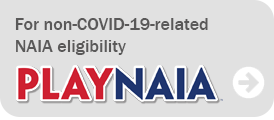Scheduling & Competition FAQs
DECLARATION OF INTENT / CHAMPIONSHIPS (Added 8/3/2020)
Q: Our institution plans to conduct some regular season competition in the fall. Should we notify the national office? (Added 8/3/2020)
THRESHOLD APPROACH
SCHEDULING & GAME LIMITS
Q: Game reductions were previously announced. Has this changed in light of the rescheduling of sport championships? (Updated 8/3/2020)
Q: Are scrimmage and exhibition games allowed to be scheduled as normal, or are they restricted in some way? (Updated 8/3/2020)
Q: What do we do if our whole team has to be in isolation for 2 weeks, and I have already used all three of my break periods? (Added 8/20/2020)
START DATES
Please note that this structure intentionally builds in three weeks of practice in keeping with healthcare guidance as well as significant membership feedback. Accordingly, we would encourage institutions to ensure that any of NAIA teams are appropriately conditioned and acclimatized before returning to competition in the fall term.
As soon as you involve students or individuals who are not identified with your school (another school’s team, an adult men’s league soccer team, etc.), it can no longer be considered a practice. At that point, you must consider it a contest of some kind (scrimmage, exhibition or game), and these competitions cannot occur until September 5 (September 12 for football).
PRACTICE
- Film review sessions involving a coach and one or more student-athletes
- Walkthrough drills (regardless of the use of equipment)
- Individual skills workouts (batting practice, putting lessons, etc.) involving a member of the coaching staff
- Open gyms that are attended and observed by a member of the coaching staff
For more information, view this entry in the NAIA Interpretation Library.
For more information, view this entry in the NAIA Interpretation Library.
To be clear, this interpretation applies to summer camps that NAIA coaches/students run for local youth or similar populations. This interpretation does NOT apply to a “camp” that is run by your coaching staff for your student-athletes, such as a “summer boot camp.” This type of boot camp is considered practice and is not permitted this summer.
For example, when acting in the role of club coach, he cannot leverage any of the benefits of also being a coach for your institution: the coach can’t give the players special access to school facilities or equipment that wouldn’t be available to all other club coaches; if there’s a fee for the public to rent the gym then the coach would have to pay the full fee.
The same is true as it relates to NAIA recruiting rules. The summer club team might also include student-athletes who attend a different college. As their club coach, the coach has to be able to initiate contact with them, even though typically NAIA rules would prevent an NAIA coach from initiating contact with players from another institution.
TRYOUTS
Q: Can multiple potential student-athletes tryout at the same time? (Added 6/25/2020)
Q: What would happen if a current student-athlete participated in a tryout with a prospective student-athlete on July 1, 2020? (Added 6/25/2020)
Q: Where can tryouts be conducted? (Added 6/25/2020)

